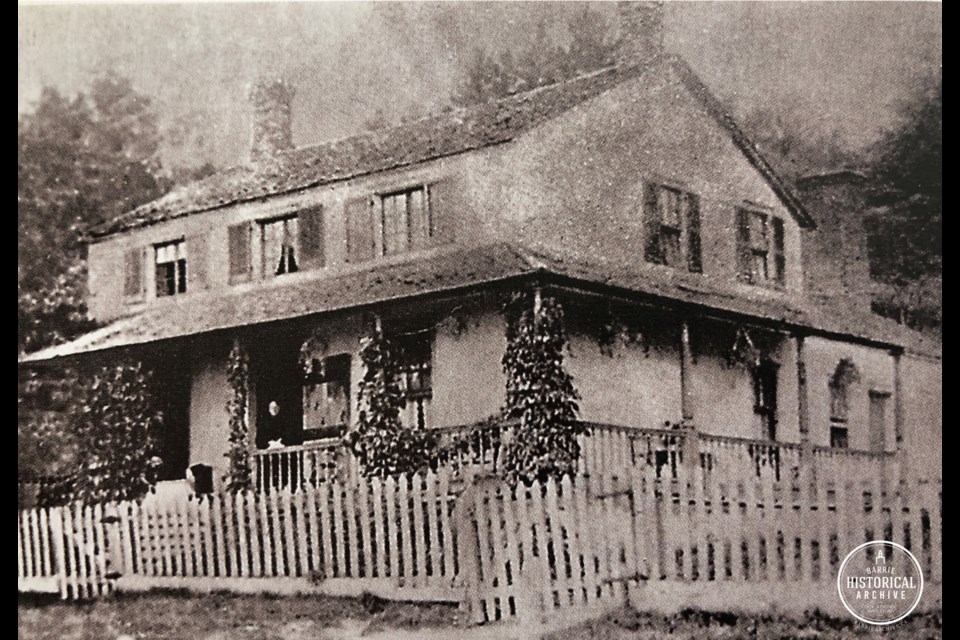This ongoing series from Barrie Historical Archive curator Deb Exel shows old photos from the collection and one from the present day, as well as the story behind them.
190 Shanty Bay Rd.
The village of Kempenfeldt (which included a 'd' in its original spelling) on the north shore of Kempenfelt Bay was the starting point of the old Penetanguishene Road. To put in terms of more familiar, modern reference points, our Kempenfeldt destination is on Shanty Bay Road, about halfway between Johnson’s Beach and Thunder Bridge.
As early as 1812, the village of Kempenfeldt — bounded on the west by Hewson (now Puget Street), O’Brien on the east, Steel (Steele) Street to the north, and the bay on the south — had been surveyed into building lots. Penetanguishene Road separated the village of Kempenfeldt, in the Township of Vespra, from Oro Township.
This area is now the dividing line between the City of Barrie and Oro-Medonte Township.
Big things were planned for Kempenfeldt. The British military had selected Penetanguishene as the site for its naval base in 1814 and determined a road was required from the military establishment to Kempenfelt Bay. Construction on Penetanguishene Road began late in 1814, its crew of soldiers led by Dr. William ‘Tiger’ Dunlop.
Dunlop was a bit of legend, so the story goes. A big man with bright red hair and beard, Dunlop was known for his quirky ways, particularly his policy of travelling with his ‘12 apostles’ – a dozen gallon bottles of brandy and whisky, toted in a wheeled box.
Settlers and villages began to appear along Penetanguishene Road as it was developed.
Kempenfeldt was to be a military supply depot, with anticipated commercial growth in the surrounding area. And growth most certainly did follow, with the movement of settlers to Simcoe County. While Barrie only had two storage buildings in 1831, Kempenfeldt boasted four taverns, a general store, a brewery, a carpenter, a brick kiln, a wharf and a tailor as well as housing, including log barracks for military troops.
Both Kempenfeldt and the village of Tollendal were contenders for the county centre at the time (the original town site for Barrie was not surveyed until 1833). Ferries to and from Kempenfeldt across the lake (or over the ice in the winter) to Holland Landing were part of the route for moving supplies, products and military personnel between the naval base and York.
Brewing and distilling was an important industry in Kempenfeldt. Many of the early settlers and military officers were English and their drink of choice was beer. A brewery was built in 1832 by William Mann, who later leased it to Barrie’s first mayor, Robert Simpson. Simpson moved his brewery over to Tollendal in 1842 following a disastrous fire. He later had a brewery in Barrie.
Having your own brewery or distillery was a definite advantage for tavern owners, such as Thrift Meldrum, who had a hotel in Barrie. Meldrum started up a small distillery in Kempenfeldt in the 1830s, which he later relocated to Tollendal on Lover’s Creek.
John Sibbald, an early settler to Tollendal in 1832, opened a log tavern in 1833. Sibbald’s Tavern was a convenient ‘rest point’ when mail service between Penetanguishene and Holland Landing started in 1833. Sibbald was partner in a ferry service with a fellow tavern owner named Ladd, across the bay in Kempenfeldt. Sibbald would row mailmen over to Kempenfeldt and Ladd would row them back to Tollendal on their return trip.
Mr. Ladd enjoyed his work and his drink… too much, sadly, as he drowned in the bay while under the influence. The new pub Ladd had built in Kempenfeldt just before his death still stands today.
The former Ladd property at 190 Shanty Bay Rd., is on Barrie’s municipal heritage register.



